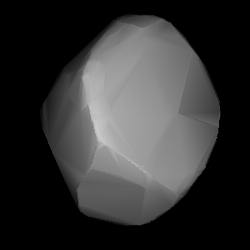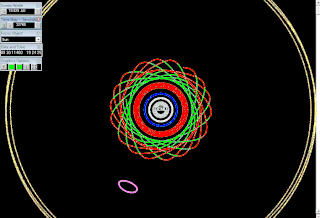Related Research Articles
3728 IRAS, provisional designation 1983 QF, is a stony asteroid from the middle region of the asteroid belt, approximately 20 kilometers in diameter. On 23 August 1983, it was discovered by and later named after IRAS, a spaceborne all-sky infrared survey satellite.

2985 Shakespeare (prov. designation: 1983 TV1) is a stony Koronian asteroid from the outer region of the asteroid belt. It was discovered on 12 October 1983, by American astronomer Edward Bowell at Lowell's Anderson Mesa Station near Flagstaff, Arizona, and later named after William Shakespeare. The presumed S-type asteroid has a rotation period of 6.1 hours and measures approximately 10 kilometers (6.2 miles) in diameter.

1743 Schmidt, provisional designation 4109 P-L, is a dark background asteroid from the inner regions of the asteroid belt, approximately 19 kilometers in diameter. It was discovered during the Palomar–Leiden survey on 24 September 1960, by astronomers Ingrid and Cornelis van Houten at Leiden, on photographic plates taken by Tom Gehrels at Palomar Observatory in California. The C-type asteroid has a rotation period of 17.5 hours. It was named for the optician Bernhard Schmidt.

1958 Chandra is a dark background asteroid from the outer region of the asteroid belt, approximately 35 kilometers in diameter. It was discovered on 24 September 1970, by Argentinian astronomer Carlos Cesco at the Yale–Columbia Southern Station of the Leoncito Astronomical Complex in San Juan, Argentina (also see Félix Aguilar Observatory). It was named after astrophysicist Subrahmanyan Chandrasekhar.
1988 Delores, provisional designation 1952 SV, is a stony Florian asteroid from the inner regions of the asteroid belt, approximately 5 kilometers in diameter.
1034 Mozartia, provisional designation 1924 SS, is a stony asteroid from the inner regions of the asteroid belt, approximately 8 kilometers in diameter. It was discovered on 7 September 1924, by Soviet Vladimir Albitsky at Simeiz Observatory on the Crimean peninsula, and named after Wolfgang Amadeus Mozart.
2531 Cambridge, provisional designation 1980 LD, is a stony Eoan asteroid from the outer regions of the asteroid belt, approximately 20 kilometers in diameter. It was discovered on 11 June 1980, by American astronomer Edward Bowell at Lowell's Anderson Mesa Station in Arizona, United States. The asteroid was named for the "centers of learning in England and in Massachusetts".
1918 Aiguillon provisional designation 1968 UA, is a dark asteroid from the outer region of the asteroid belt, approximately 20 kilometers in diameter.
1553 Bauersfelda, provisional designation 1940 AD, is a stony Koronian asteroid from the outer regions of the asteroid belt, approximately 13 kilometers in diameter. It was discovered on 13 January 1940, by astronomer Karl Reinmuth at the Heidelberg Observatory in southwest Germany. The asteroid was named after German engineer Walther Bauersfeld.
2034 Bernoulli, provisional designation 1973 EE, is a stony asteroid from the inner regions of the asteroid belt, approximately 9 kilometers in diameter.

2490 Bussolini is an Eunomia asteroid from the central region of the asteroid belt, approximately 12 kilometers in diameter. It was discovered on 3 January 1976, by staff members of the Félix Aguilar Observatory at El Leoncito Complex in Argentina. The asteroid was named after Argentine Jesuit physicist Juan Bussolini.

5222 Ioffe, provisional designation 1980 TL13, is a rare-type carbonaceous Palladian asteroid from the central region of the asteroid belt, approximately 18 kilometers in diameter. It was discovered on 11 October 1980, by Soviet astronomer Nikolai Chernykh at the Crimean Astrophysical Observatory in Nauchnyj, Crimea. It is the largest of the Palladian asteroids apart from Pallas itself.
7476 Ogilsbie, provisional designation 1993 GE, is a carbonaceous asteroid from the outer region of the asteroid belt, approximately 20 kilometers in diameter. It was discovered by American astronomer Timothy Spahr at the U.S. Catalina Station in Tucson, Arizona, on 14 April 1993.
1857 Parchomenko, provisional designation 1971 QS1, is a stony asteroid and suspected binary from the inner regions of the asteroid belt, approximately 8 kilometers in diameter.
2122 Pyatiletka, provisional designation 1971 XB, is a stony asteroid from the inner regions of the asteroid belt, approximately 11 kilometers in diameter.

2384 Schulhof (prov. designation: 1943 EC1) is a mid-sized asteroid and the namesake of the Schulhof family, located in the Eunomian region of the intermediate asteroid belt. It was discovered on 2 March 1943, by French astronomer Marguerite Laugier at Nice Observatory in southeastern France. The asteroid was later named after Hungarian astronomer Lipót Schulhof. The presumed S-type asteroid has a short rotation period of 3.3 hours and measures approximately 12 kilometers (7.5 miles) in diameter.
1737 Severny, provisional designation 1966 TJ, is a stony Eoan asteroid from the outer region of the asteroid belt, approximately 21 kilometers in diameter.

1704 Wachmann, provisional designation A924 EE, is a stony asteroid from the inner regions of the asteroid belt, approximately 7 kilometers in diameter. It was discovered by German astronomer Karl Reinmuth at Heidelberg Observatory on 7 March 1924. It was later named after astronomer Arno Wachmann.
1887 Virton, provisional designation 1950 TD, is a stony Eoan asteroid from the outer region of the asteroid belt, approximately 21 kilometers in diameter. It was discovered by Belgian astronomer Sylvain Arend at the Royal Observatory of Belgium in Uccle on 5 October 1950, and named after the Belgian town of Virton.
6117 Brevardastro, provisional designation 1985 CZ1, is a stony asteroid from the inner regions of the asteroid belt, approximately 5 kilometers in diameter.
References
- 1 2 3 4 "JPL Small-Body Database Browser: 3412 Kafka (1983 AU2)" (2017-06-02 last obs.). Jet Propulsion Laboratory . Retrieved 17 June 2017.
- 1 2 3 Schmadel, Lutz D. (2007). "(3412) Kafka". Dictionary of Minor Planet Names – (3412) Kafka. Springer Berlin Heidelberg. p. 284. doi:10.1007/978-3-540-29925-7_3412. ISBN 978-3-540-00238-3.
- 1 2 3 Masiero, Joseph R.; Grav, T.; Mainzer, A. K.; Nugent, C. R.; Bauer, J. M.; Stevenson, R.; et al. (August 2014). "Main-belt Asteroids with WISE/NEOWISE: Near-infrared Albedos". The Astrophysical Journal. 791 (2): 11. arXiv: 1406.6645 . Bibcode:2014ApJ...791..121M. doi:10.1088/0004-637X/791/2/121.
- 1 2 Erasmus, N.; Kramer, D.; McNeill, A.; Trilling, D. E.; Janse van Rensburg, P.; van Belle, G. T.; Tonry, J. L.; Denneau, L.; Heinze, A.; Weiland, H. J. (September 2021). "Discovery of superslow rotating asteroids with ATLAS and ZTF photometry". Monthly Notices of the Royal Astronomical Society. 506 (3): 3872–3881. arXiv: 2106.16066 . Bibcode:2021MNRAS.506.3872E. doi: 10.1093/mnras/stab1888 .
- 1 2 "3412 Kafka (1983 AU2)". Minor Planet Center. Retrieved 5 December 2016.
- ↑ Edberg & Levy 1994, p. 80.
- ↑ "LCDB Data for (3412) Kafka". Asteroid Lightcurve Database (LCDB). Retrieved 10 September 2023. (Enter 3412 as upper and lower range for the asteroid number, then press "submit".)
- ↑ "MPC/MPO/MPS Archive". Minor Planet Center. Retrieved 5 December 2016.
- Bibliography
- Edberg, Stephen J.; Levy, David H. (1994). Observing, Comets, Asteroids, Meteors, and the Zodiacal Light. Cambridge: Cambridge University Press. ISBN 978-0-521-42003-7.